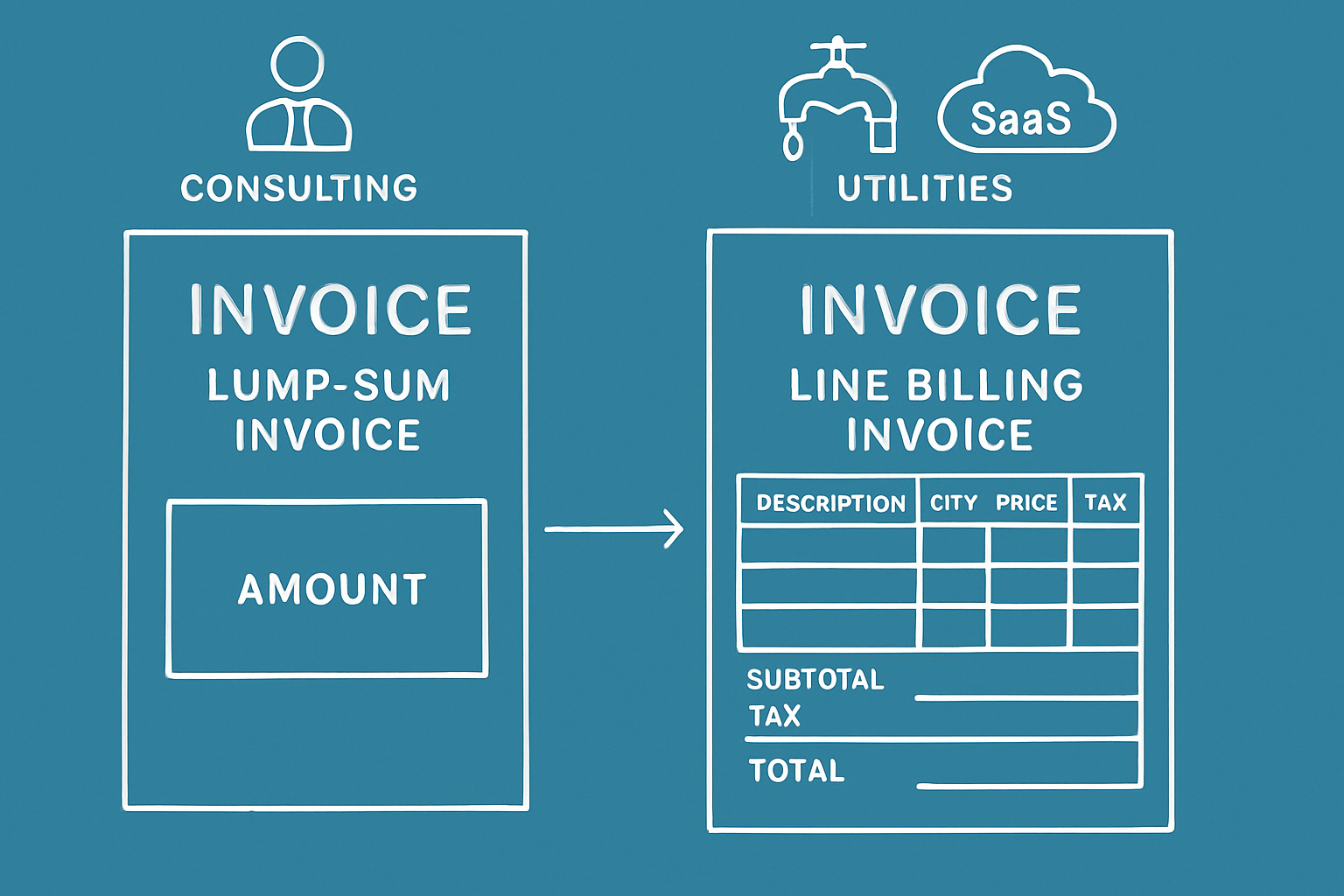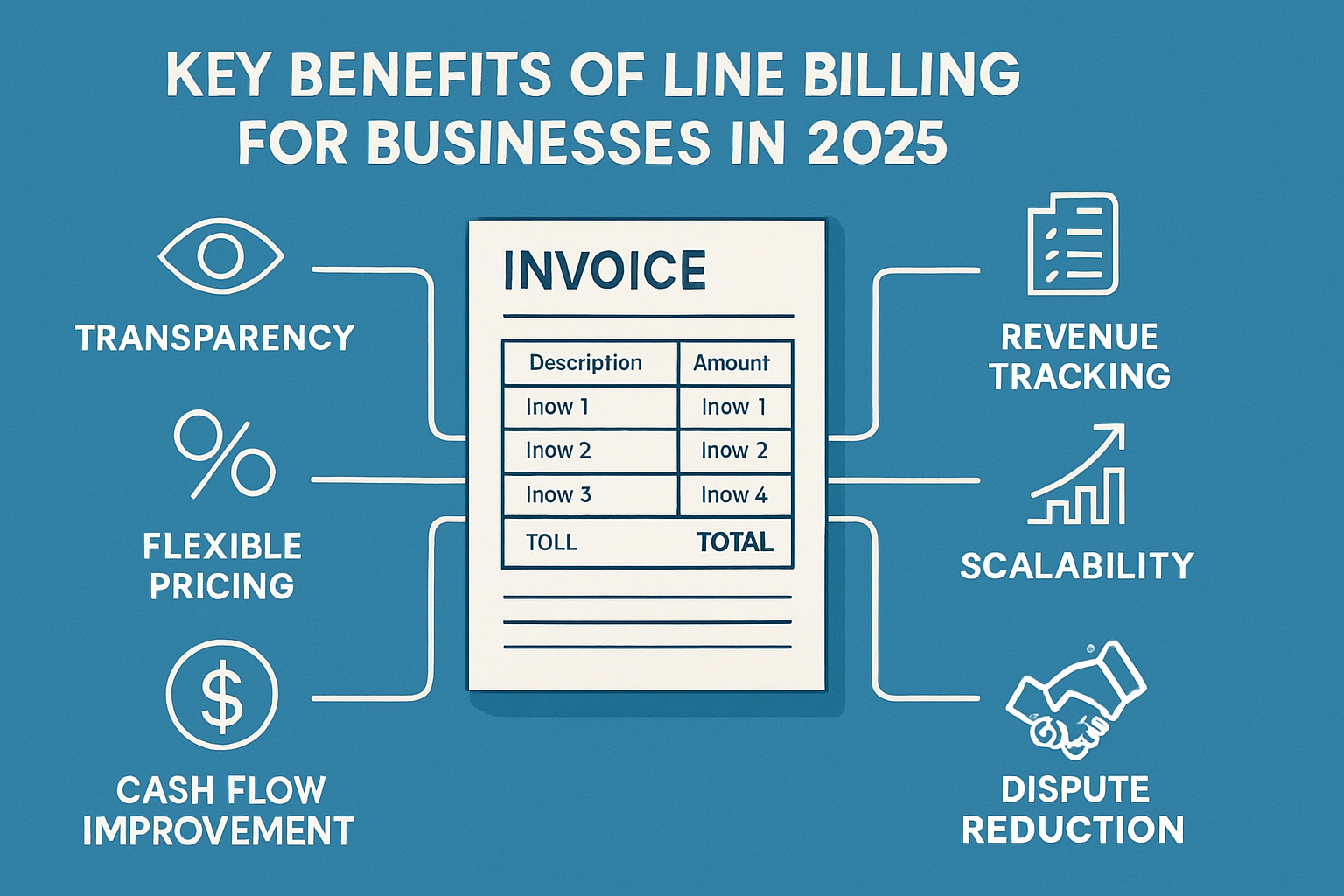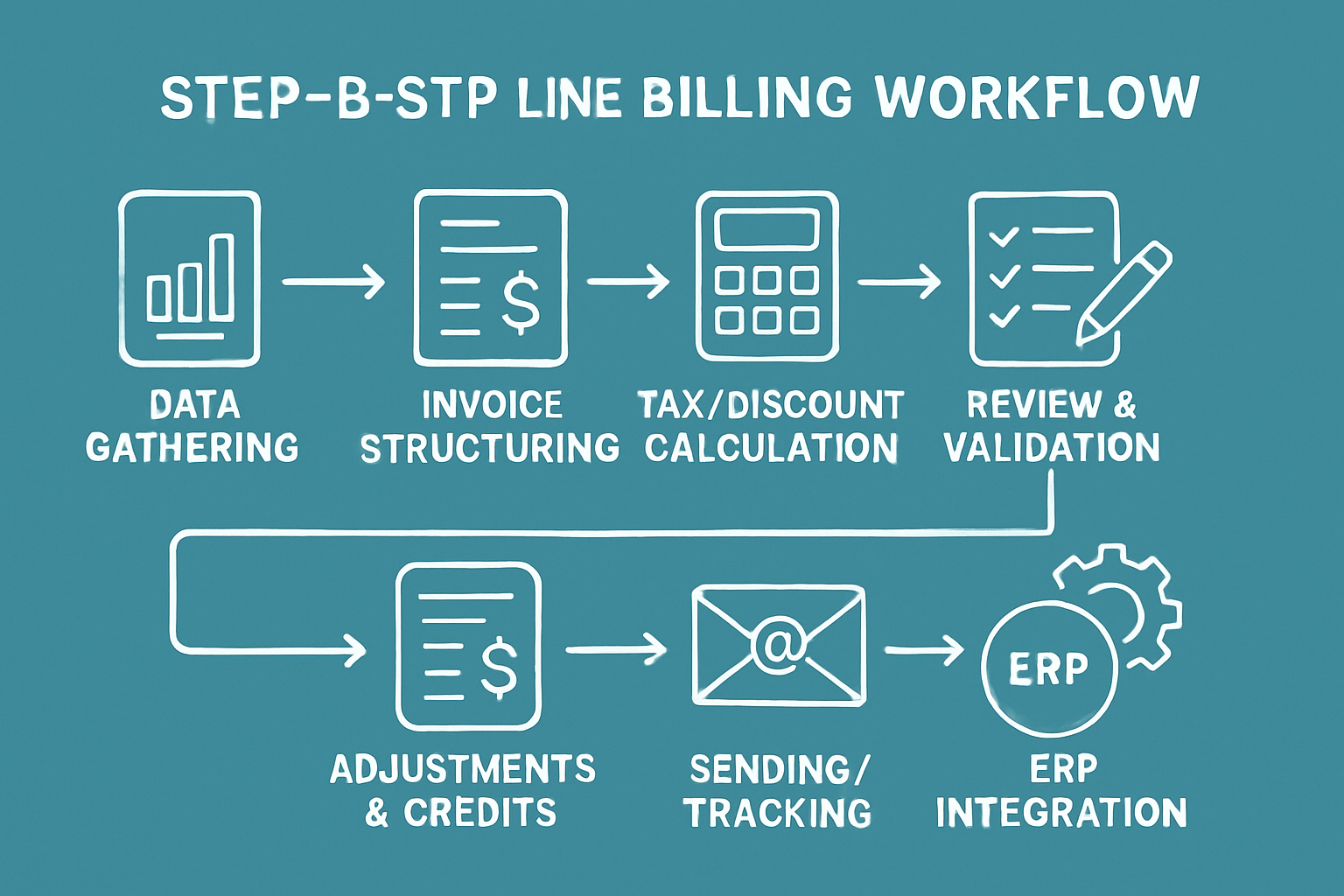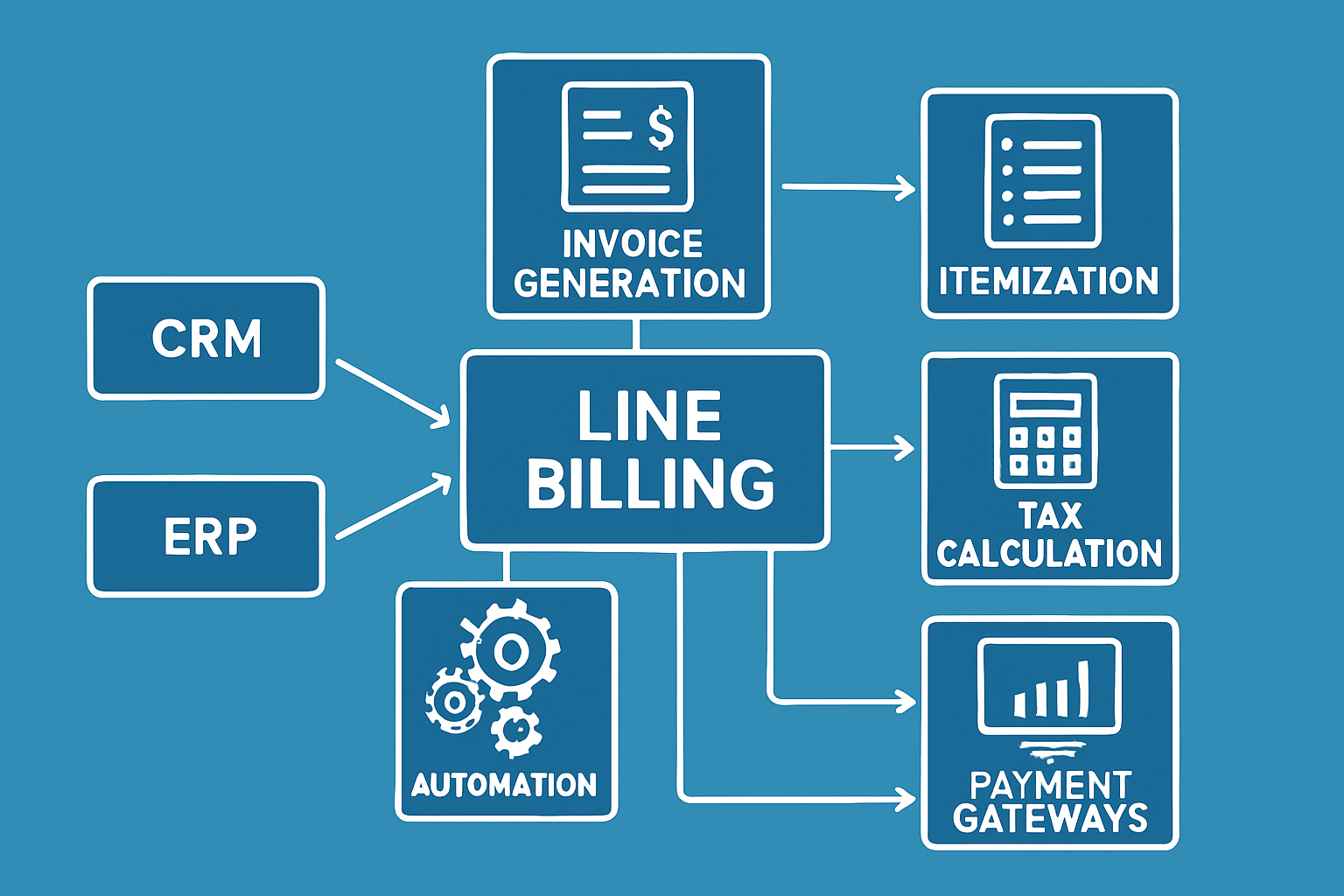What is Line Billing?
Line billing is a modern invoicing approach that replaces the traditional lump-sum method with detailed, itemized charges for every product or service provided. Unlike a single total, line billing breaks down each component—giving both businesses and clients a transparent view of all charges. This method is especially useful for companies seeking accuracy, accountability, and easier analysis of their invoices. If you're curious about how to implement or analyze this billing style, this line item analysis in invoices guide dives deeper into its practical benefits.

Definition and Core Concepts
At its core, line billing means presenting each charge as a separate line on an invoice. Instead of one vague total, you see every service or product listed out, complete with details. For example, a consulting invoice might show hours for different team members, while a SaaS bill could break down charges by feature or usage.
Common scenarios for line billing include:
- Consulting projects with variable hours or roles
- Utility companies charging for energy consumption by meter
- SaaS businesses billing by user, feature, or usage tier
- Construction firms itemizing labor, materials, and equipment
This format not only simplifies communication but also builds trust with clients who want to know exactly what they're paying for.
Key Components of a Line Bill
A well-structured line billing invoice includes several crucial elements:
- Item descriptions: Clear explanation of each product or service
- Quantities: Number of units, hours, or sessions
- Unit prices: Cost per item or service
- Taxes: Applied at the line item or invoice level
- Totals: Subtotals and grand total for easy reference
Clarity is essential. When line billing is used, clients can quickly verify charges, spot errors, and understand the breakdown—reducing confusion and disputes.
Common Industries Using Line Billing
Line billing is standard in several industries where transparency and detail are critical. Some prominent examples include:
- Legal services: Lawyers bill by time spent on specific tasks or case segments
- Healthcare: Providers itemize procedures, lab work, and medications
- IT services: Firms charge by project milestones or hours per specialist
Industry-specific formats may add custom fields, such as patient information for healthcare or task codes for legal work, making line billing adaptable to various needs.
Line Billing vs. Other Billing Methods
How does line billing compare to other popular billing approaches? Here's a quick breakdown:
| Method |
Structure |
Pros |
Cons |
| Line Billing |
Itemized per charge |
High transparency, easy analysis |
More setup, detailed input |
| Milestone |
By project phase |
Good for long projects |
Less detail, harder to audit |
| Retainer |
Prepaid block |
Predictable cash flow |
Can hide over/underuse |
| Flat-rate |
One total price |
Simple, fast |
Lacks detail, less flexible |
Line billing stands out for businesses that value clarity and want to minimize billing errors.
Real-World Example
Let’s walk through a simple line billing invoice for a web development project:
| Description |
Quantity |
Unit Price |
Tax |
Total |
| Website Design |
10 hrs |
$80 |
$0 |
$800 |
| Hosting (3 months) |
3 |
$20 |
$3 |
$63 |
| Maintenance |
5 hrs |
$50 |
$0 |
$250 |
This breakdown shows exactly what the client is paying for, making line billing a powerful tool for both providers and customers.
Benefits of Line Billing for Businesses
Implementing line billing is a strategic move for businesses aiming to boost efficiency and transparency in their financial processes. The benefits extend far beyond simple invoicing, transforming how organizations manage revenue, build trust, and scale operations.

Improved Transparency and Client Trust
Line billing creates detailed, itemized invoices that list every product or service provided. This structure makes it easy for clients to understand exactly what they're paying for, reducing confusion and building confidence.
Clients are less likely to dispute charges when each line is clearly described. In fact, businesses adopting line billing often report a noticeable drop in billing errors and client complaints.
Enhanced Revenue Tracking and Analysis
With line billing, each charge is tracked individually. This approach allows businesses to analyze sales trends and profitability at a granular level, which is especially valuable for companies offering diverse services or products.
For example, a SaaS provider can monitor which features are most popular by reviewing line item data. This insight helps drive smarter business decisions and tailored offerings.
Streamlined Auditing and Compliance
Line billing supports audit-readiness by maintaining detailed records of every transaction. When regulators or auditors review your books, itemized invoices make it easy to verify charges and ensure compliance.
Adopting automation tools, as highlighted in the AI Invoice Parsing Guide 2025, helps businesses avoid common mistakes and prepare for hassle-free audits.
Flexible Pricing and Upselling Opportunities
The flexibility of line billing allows companies to itemize add-ons, customizations, or extra services. By clearly listing these options, businesses can encourage clients to select upgrades or additional features.
This method not only increases revenue but also gives customers a clear view of available choices, enhancing their overall experience.
Better Cash Flow Management
Clear, understandable invoices produced through line billing lead to faster payments. When clients can easily verify each charge, they are more likely to pay on time, improving cash flow.
Businesses using line billing have reported payment cycles that are up to 25% shorter compared to those relying on lump-sum invoicing.
Reduced Disputes and Chargebacks
Misunderstandings over vague charges are a common cause of disputes. With line billing, every charge is transparent, which means fewer disagreements and a lower risk of costly chargebacks.
Legal firms, for instance, have seen a reduction in client disputes after making the switch to itemized billing.
Scalability for Growing Businesses
As businesses expand and diversify their offerings, line billing scales effortlessly. Adding new products or services is as simple as updating the invoice template, making growth manageable and stress-free.
This adaptability ensures that financial processes remain smooth and organized, even as transaction volumes increase.
How Line Billing Works: Step-by-Step Guide
Understanding how line billing works in practice is essential for getting the most out of this powerful invoicing method. Let’s walk through each stage, so you can confidently build a seamless line billing process from start to finish.

Step 1: Gathering Accurate Data
The first step in line billing is collecting all relevant and accurate details about products or services provided. This means capturing item descriptions, quantities, unit prices, and any special conditions.
Using automated systems or integrating with inventory software can help businesses avoid manual errors. For example, syncing with a service tracking system ensures each deliverable is recorded in real time.
Accuracy at this stage sets the foundation for the entire line billing process. If your data is off, every following step is affected. Consistent, up-to-date records make it much easier to create precise invoices and maintain trust with clients.
Step 2: Structuring the Invoice
Once you have your data, it’s time to organize it into a clear, logical invoice format. In line billing, each product or service appears as a separate line item, with details such as description, quantity, and price.
Arrange line items by date, project, or category to make the invoice easy to read. Use clear, concise descriptions so clients know exactly what they’re being charged for.
Here’s a simple example of line billing structure:
| Description |
Quantity |
Unit Price |
Total |
| Consulting Hours |
10 |
$100 |
$1000 |
| Software License |
2 |
$250 |
$500 |
A well-structured invoice helps prevent confusion and ensures line billing delivers on its promise of transparency.
Step 3: Calculating Taxes and Discounts
Next, apply taxes, discounts, or surcharges to each line item as needed. This is a key advantage of line billing, allowing for precise tax compliance and flexible pricing.
For example, you might apply a sales tax only to taxable items, or offer a discount for bulk services. Always verify local tax laws to ensure you’re charging the correct rates on each line.
Automating calculations within your invoicing software reduces errors and speeds up the process. With line billing, your clients can see exactly how taxes and discounts affect each charge, minimizing disputes.
Step 4: Reviewing and Validating the Invoice
Before sending an invoice, double-check every detail for accuracy. Review item descriptions, numbers, prices, and applied taxes. Mistakes at this stage can lead to payment delays or client dissatisfaction.
Consider setting up a checklist or using automated validation tools to catch common errors. Regular audits are also a smart move. For a deeper dive into optimizing this process, check out these Invoice Management Best Practices 2025.
Consistent validation ensures your line billing system remains reliable and trusted by clients.
Step 5: Sending and Tracking the Invoice
Once validated, send the invoice through your client’s preferred channel—email, secure portal, or electronic data interchange (EDI). Many businesses use line billing templates to streamline this step.
Tracking payment status is crucial. Modern invoicing platforms can notify you when an invoice is viewed, paid, or overdue. This helps you follow up efficiently and keeps cash flow healthy.
Prompt, professional delivery paired with robust tracking is a hallmark of effective line billing.
Step 6: Handling Adjustments and Credits
Sometimes, clients need changes after an invoice is sent. Line billing makes it easy to issue credits, refunds, or adjustments for individual items.
For example, if a customer returns part of their order, you can adjust just that line rather than the entire invoice. This level of granularity keeps records clean and clients satisfied.
Clear documentation of adjustments ensures everyone stays on the same page and supports smooth reconciliation later.
Step 7: Integrating with Accounting and ERP Systems
The final step is integrating your line billing process with accounting or ERP systems. This automation ensures invoice data flows directly into your financial records, reducing manual entry and errors.
Integration enables real-time reporting, easier audits, and seamless reconciliation. As your business grows, this step becomes vital for managing high invoice volumes and maintaining financial accuracy.
A connected line billing workflow gives you the flexibility and control needed for modern business operations.
Essential Tools & Software for Line Billing
Choosing the right tools is crucial for successful line billing. Modern businesses rely on specialized software to ensure accuracy, transparency, and efficiency. The right platform can make all the difference in how you manage, automate, and scale your invoicing process.

Key Features to Look For
When evaluating line billing software, focus on features that support detailed, itemized invoicing. Essential capabilities include:
- Customizable templates for different industries
- Easy itemization of products and services
- Automatic tax and discount calculations
- Batch invoice processing
- Clear reporting and analytics
For comparison, here's how leading platforms stack up:
| Platform |
Itemization |
Tax Automation |
Templates |
Automation |
| QuickBooks |
Yes |
Yes |
Yes |
Yes |
| Xero |
Yes |
Yes |
Yes |
Yes |
| FreshBooks |
Yes |
Yes |
Yes |
Yes |
Selecting tools with robust line billing features ensures both compliance and client satisfaction.
Integration Capabilities
Integration is a game changer in line billing. The most effective systems connect seamlessly with existing CRM, ERP, and payment gateways. This linkage reduces manual work, helps maintain data accuracy, and streamlines the billing cycle.
Look for solutions offering:
- Real-time data sync between line billing and accounting platforms
- API support for custom integrations
- Compatibility with popular business tools
By integrating line billing into your software ecosystem, you can eliminate data silos and foster a smoother workflow.
Automation and Error Reduction
Automation is transforming line billing. Modern platforms offer features like recurring invoices, scheduled reminders, and automatic payment matching. These tools reduce manual entry, saving time and minimizing errors.
Research, such as the Better Bill GPT Study, shows that AI-powered solutions are now outperforming humans in reviewing complex legal invoices, further boosting efficiency and accuracy in line billing environments.
Automation also means fewer missed payments and faster cash flow, both essential for growing businesses.
Security and Compliance
Data protection is non-negotiable in line billing. Choose tools that follow industry standards and offer:
- End-to-end encryption
- Two-factor authentication
- Regular security audits
- Compliance certifications (like SOC 2, GDPR)
These features safeguard sensitive client and financial data, helping your business meet legal and regulatory requirements.
Staying compliant with evolving regulations is easier when your line billing software is regularly updated and certified.
Cost Considerations
Budget is always a factor when choosing line billing software. Pricing models vary:
- Subscription-based: Monthly or annual fees
- Per-invoice: Charges per invoice sent
- Enterprise: Custom pricing for high-volume needs
When evaluating options, consider the return on investment. Automated line billing reduces manual labor, cuts errors, and speeds up payments—often justifying the initial spend.
Scalability and Customization
As your business grows, so do your billing needs. The best line billing solutions are scalable and customizable. They support:
- Increasing invoice volumes
- Diverse product or service lines
- Unique workflows and branding
For example, companies have successfully scaled from 50 to 5,000 invoices per month by leveraging flexible line billing platforms. Custom fields, advanced reporting, and workflow automation allow you to adapt as you expand.
Best Practices and Common Pitfalls in Line Billing
Implementing line billing effectively takes more than just software. To truly maximize its value and avoid headaches, it’s essential to follow best practices and steer clear of common mistakes. Let’s break down what you need to know to keep your line billing process smooth, professional, and client-friendly.
Clear and Consistent Descriptions
Clear, standardized descriptions are the foundation of reliable line billing. Every line item should use uniform naming conventions and avoid jargon. This reduces confusion for both clients and your team.
- Use consistent product/service names.
- Include necessary details, such as dates or project phases.
- Avoid abbreviations unless previously defined.
Clients appreciate transparency, and clarity helps prevent disputes. When line billing is implemented with clear descriptions, misunderstandings drop, and trust increases.
Regular Invoice Audits
Regular audits are essential to catch errors before they become bigger problems. Set a recurring schedule—monthly or quarterly—to review a sample of invoices.
- Look for duplicate line items or incorrect quantities.
- Check that taxes and discounts are applied correctly.
- Compare invoice totals with supporting documentation.
According to industry research, companies that audit invoices regularly catch up to 30% more mistakes. You can find more guidance on invoice audits in the ACFE’s billing best practices.
Training Staff and Setting Policies
A well-trained billing team ensures consistency and accuracy. Start with onboarding sessions focused on your line billing process.
- Develop internal guidelines for invoice creation.
- Provide refresher training when you update software or policies.
- Assign a go-to person for answering billing questions.
When your team is aligned, line billing becomes a reliable backbone for your financial operations.
Managing Client Expectations
Managing expectations is key for a positive billing experience. Explain your line billing process to clients upfront, outlining what they’ll see on each invoice.
- Share sample invoices during onboarding.
- Clarify billing cycles and payment terms.
- Invite questions to clear up confusion early.
For example, an IT firm reduced client disputes by 40% simply by providing a billing FAQ and walking clients through their first invoice.
Avoiding Overcomplication
While detail is valuable, too much can overwhelm your clients. Aim for a balanced approach in your line billing structure.
- Only include relevant information for each charge.
- Group similar items where possible.
- Use clear headings to organize complex invoices.
Keeping line billing simple helps clients focus on what matters and speeds up payment approval.
Handling Disputes Professionally
Disputes are inevitable, but a structured approach can turn a negative into a positive. Respond quickly and keep communication open.
- Use templates for replying to billing concerns.
- Document all correspondence.
- Offer partial credits or adjustments when justified.
A calm, methodical response can resolve most issues without escalating, keeping your client relationships intact.
Staying Updated with Regulations
Laws and industry standards evolve, so staying informed is crucial for compliant line billing. Assign someone to monitor tax updates, privacy rules, and invoicing requirements.
- Subscribe to industry newsletters for alerts.
- Review your process annually for compliance gaps.
- Update invoice templates as regulations change.
A recent example: In 2025, new VAT rules required many businesses to adjust their line billing formats to remain compliant.
The Future of Line Billing: Trends to Watch in 2025
The world of line billing is evolving rapidly as technology, customer needs, and regulations shift. Staying ahead of these changes is essential for businesses that want to remain competitive and efficient. Let’s explore the top trends shaping line billing in 2025.
Automation and AI in Billing
Automation and AI are revolutionizing line billing by streamlining processes and minimizing errors. AI-powered tools can extract data from receipts, parse invoices, and even detect anomalies before invoices are sent.
For example, advanced billing platforms now offer machine learning features that auto-categorize expenses and flag inconsistencies. According to Gartner’s trends in finance automation, businesses adopting AI in billing see significant reductions in manual workload and error rates.
As line billing systems embrace more automation, expect faster processing and fewer disputes.
Real-Time and Dynamic Billing
Real-time billing is becoming standard in industries like SaaS and utilities, where usage can fluctuate rapidly. With line billing, businesses can instantly reflect changes in service levels or consumption.
Dynamic billing models allow for flexible pricing, immediate updates to invoices, and better alignment between service delivery and payment. This trend ensures that clients always see up-to-date, accurate line billing details, leading to improved trust and transparency.
Integration with Analytics and BI Tools
Integrating line billing with analytics and business intelligence (BI) tools is transforming how companies use their billing data. Detailed invoice line items can now feed directly into dashboards for real-time profit analysis, trend spotting, and decision-making.
Companies are leveraging these insights to optimize pricing, identify popular products, and forecast demand more accurately. As a result, line billing is becoming not just a financial necessity but a strategic asset.
Customer Experience Enhancements
Customer expectations are rising, and line billing is adapting to meet them. Interactive invoices, client self-service portals, and personalized billing experiences are gaining traction.
Clients can now view line billing details, track payments, and ask questions directly through digital portals. These enhancements reduce friction, speed up payment cycles, and provide a more transparent experience. Businesses that prioritize customer-centric billing processes will stand out in 2025.
Regulatory and Compliance Developments
Compliance is a moving target, especially with new tax, privacy, and e-invoicing regulations on the horizon. Line billing systems are evolving to help businesses stay compliant with global standards.
Automated tax calculation, audit trails, and secure data handling are now must-have features. Companies that monitor regulatory changes and update their line billing practices accordingly will minimize risk and avoid costly penalties.
Sustainability and Paperless Billing
Sustainability is influencing every business process, including line billing. Digital invoices reduce paper use and carbon footprint, supporting corporate environmental goals.
With line billing, businesses are moving toward fully paperless workflows. This shift not only benefits the environment but also streamlines operations and reduces costs. As digital adoption grows, line billing will play a pivotal role in building a greener future.
Now that you’ve seen how line billing can transform the way you handle invoices—making your process clearer, faster, and more accurate—why not take the next step? If you’re ready to put your new knowledge into action or just want to see how easy AI-powered invoice extraction can be, I recommend trying out the Free Invoice Parser. You’ll be able to quickly pull out key data like vendor details and line items, export to Excel or Power BI, and see firsthand how automation can simplify your workflow. Give it a spin and see the difference for yourself!




